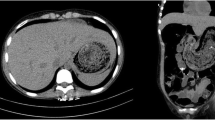Abstract
Gossypol trichobezoar consists of a compact interwoven mass of hair along with cotton fibers occupying the gastrointestinal tract. When the bezoar extends past the duodenum, it is referred to as Rapunzel syndrome. Trichobezoars are found mostly in females and they may be associated with psychiatric conditions such as trichotillomania and trichophagia. We present a case of a 15-year-old female child presented to our surgical outpatient clinic with palpable mobile epigastric lump and dyspeptic symptoms with early satiety. Imaging studies revealed presence of gastrointestinal foreign body with entangled appearance extending up to ileum. Endoscopy revealed presence of trichobezoar in the stomach extending into the duodenum. The patient underwent laparotomy and anterior oblique gastrotomy, and retrieval of gossypol trichobezoar was done, measuring 102 cm and weighing 500 g. Trichobezoars should be considered as a differential diagnosis in young female patients with epigastric mass. Majority of these patients have an underlying psychiatric disorder. Psychiatric evaluation and counseling is essential to prevent recurrence of the problem.

Similar content being viewed by others
References
Williams RS (1986) The fascinating history of bezoars. Med J Aust 60:658–660
Rabie ME, Arishi AR, Khan A, Ageely H, EL-Nasr GAS, Fagihi M (2008) Rapunzel syndrome: the unsuspected culprit. World J Gasteroenterol 14(7):1141–1143. https://doi.org/10.3748/wjg.14.1141
Naik S, Gupta V, Rangole A, Chaudary AK, Jain P, Sharma AK (2007) Rapunzel syndrome reviewed and redefined. Dig Surg 24:157–161. https://doi.org/10.1159/000102098
Silveira HJ, Coelho-Junior JA, Gestic MA, Chaim EA, Andreollo NA (2012) Giant trichobezoar: case report and literature review. Arq Bras Cir Dig 25:135–136
Sehgal VN, Srivastava G (2006) Trichotillomania + trichobezoar: revisited. Eur Acad Dermartol Venerol 20:911–915
Pogorelić Z, Jurić I, Zitko V, Britvić-Pavlov S, Biocić M (2012) Unusual cause of palpable mass in upper abdomen—giant gastric trichobezoar: report of a case. Acta Chir Belg 112:160–163
Gorter RR, Kneepkens CMF, Mattens ECJL, Aronson DC, Heij HA (2010) Management of trichobezoar: case report and literature review. Pediatr Surg Int 26(5):457–463. https://doi.org/10.1007/s00383-010-2570-0
Tudor EC, Clark MC (2013) Laparoscopic assisted removal of gastric trichobezoar; a novel technique to reduce operative complications and time. J Pediatric Surg 48:e13–e15
Author information
Authors and Affiliations
Corresponding author
Ethics declarations
Conflict of Interest
The authors declare that there is no conflict of interest.
Rights and permissions
About this article
Cite this article
Ramlingam, P., Kartheek, G., Sneha Rao, K. et al. Rapunzel Syndrome—Gossypol Trichobezoar Case Report and Review of Literature. Indian J Surg 80, 524–526 (2018). https://doi.org/10.1007/s12262-017-1714-z
Received:
Accepted:
Published:
Issue Date:
DOI: https://doi.org/10.1007/s12262-017-1714-z




